Tom Owen Tom started working with wooden boats in 2002 when he attended the International Yacht Restoration School in Newport RI, USA. Since graduating from the Boatbuilding & Restoration Program there, he has used his traditional skills to restore a series of light to medium displacement racing yachts, dinghies and wooden craft from his workshop in Fowey, Cornwall.
Prior to wooden boatbuilding, Tom read Classics at Durham University and worked in various roles as a financial analyst in London. On his return from the USA in 2004, he worked at Fairlie Restorations on the Hamble and was fortunate to work on both the 19m R Mariquita and the lofting of the 15m R Hispania.
His interest in both racing yacht construction in the years before the Second World War and Scandinavian yacht designers, lead to work on several Tumlaren boats and the full restoration of Bluenose, a 1937 Knud Reimers Tumlaren built at Norrtajlie just north of Stockholm. This naturally led to an interest in the smaller metre classes and the restoration of the 6m R Valdai, a 1930 Alfred Mylne late second rule design built on the Isle of Bute.
He is currently working with his skilled team on the 6mr Marletta, a 1947 David Boyd third rule design built at Sandbanks on the Clyde for the Olympics in Torbay in 1948. Also in the yard at present are another Tumlaren Alert from 1935 and an Ullswater skiff dating from the early 1900s on Derwent Water in the Lake District.
+44 7976 403120 | tom@classicyachtrestoration.co.uk | Fowey, Cornwall

Wooden Boatbuilders' Trade Association
- Tom Owen Classic Yacht Restoration and Wooden Boatbuilding
Proprietor Tom Owen Address Windmill Industrial Estate, Fowey, Cornwall, PL23 1HB Mobile 07976 403120 Email [email protected] Web www.classicyachtrestoration.co.uk Biography Tom and his team produce quality work on wooden boats up to 45ft, specialising in classic yacht restoration of racing boats. His particular area of interest is light to medium displacement racing yachts. All restoration, new build or repair projects undertaken at the workshops in Fowey. Also offers winter and spring commissioning and repairs, outside layup and storage area for boats up to 35ft.

All Members & Affiliates
- 3D Marine (GB) Ltd
- A and R Way
- Abbey Boat Builder
- Adrian Donovan
- Alan Staley
- Alasdair Grant
- Anglia Stainless Ltd
- Archipelago Folkschool
- Avon Boating Ltd
- Ben Coombes Small Craft Ltd
- Black Dog Timber
- Boat Building Academy
- Bowker Marine Services
- Brian Kennell
- Classic Watercraft
- Cockwells Modern and Classic Boatbuilding
- Colin Henwood
- Conrad Natzio
- Coventry Boatbuilders
- Davey and Company London Ltd
- De Bootbouwschool
- Evans Boatwork
- Fabian Bush
- Forest Enterprise Scotland
- Gail McGarva
- Good Wood Boat Co
- Henry Willow Wooden Boats (Associate Member)
- Iain Oughtred (Honorary Member)
- Ian Richardson
- Jachtbauw Bart Jan Bats
- Johnson and Loftus Boatbuilding Co
- Jordan Boats and CNC Ltd
- Lakeland Wooden Boats
- Marcus Lewis
- Michael Dennett Boatbuilders
- Mike Broome
- MM Sail Solutions
- Paradise Boat Co Ltd
- R.B. Shipwrighting
- Richard le Bloas
- Rob Maloney Boatbuilders
- Ryan Kearley
- Selway-Fisher Design
- Simon Winter Marine
- South River Marine
- St. Johns Boats
- St. John's Boats
- Star Yachts Ltd
- Swallow Yachts
- Sykes Timber
- The Slipway Co-operative Ltd
- Tom Jones Boatyard
- Traditional Shipwright Services
- Tucker Designs
- Valkyrie Craft
- Water Craft Magazine
- Willow Bay Boats
- Winter & Co. (Marine) Insurance
- Wolstenholme Yacht Design Ltd
- Woodbridge Boatyard
All Regions
- East Anglia
- North and The Midlands
- Northern Ireland

Tom Owen Classic Yacht Restoration
Top quality work on wooden boats up to 45ft. Specialising in classic yacht restoration and wooden boatbuilding. Particular area of interest is light to medium displacement racing yachts. All restoration, new build or repair projects undertaken. Winter and spring commissioning and repairs.
Unit 4, Windmill Industrial Estate Fowey Cornwall PL23 1HB United Kingdom
National Historic Ships UK acknowledges the financial support of its sponsors
- The Registers
- Shipshape Network

The global authority in superyachting
- NEWSLETTERS
- Yachts Home
- The Superyacht Directory
- Yacht Reports
- Brokerage News
- The largest yachts in the world
- The Register
- Yacht Advice
- Yacht Design
- 12m to 24m yachts
- Monaco Yacht Show
- Builder Directory
- Designer Directory
- Interior Design Directory
- Naval Architect Directory
- Yachts for sale home
- Motor yachts
- Sailing yachts
- Explorer yachts
- Classic yachts
- Sale Broker Directory
- Charter Home
- Yachts for Charter
- Charter Destinations
- Charter Broker Directory
- Destinations Home
- Mediterranean
- South Pacific
- Rest of the World
- Boat Life Home
- Owners' Experiences
- Interiors Suppliers
- Owners' Club
- Captains' Club
- BOAT Showcase
- Boat Presents
- Events Home
- World Superyacht Awards
- Superyacht Design Festival
- Design and Innovation Awards
- Young Designer of the Year Award
- Artistry and Craft Awards
- Explorer Yachts Summit
- Ocean Talks
- The Ocean Awards
- BOAT Connect
- Between the bays
- Golf Invitational
- Boat Pro Home
- Pricing Plan
- Superyacht Insight
- Product Features
- Premium Content
- Testimonials
- Global Order Book
- Tenders & Equipment
Five classic superyachts brought back to life from the brink
Related articles, superyacht directory.
Not every owner relishes the prospect of a shiny new-build when they have the option to restore a beloved classic. Read on to discover some of the world’s most fascinating and valuable classic superyachts, which were brought back from the brink by their patient owners...
There is something intensely magical about the act of restoration: the feat of rescuing something that has fallen into a state of disrepair and returning it to its original condition. For owners, there is a process of falling completely for the yacht – something which compels them. British sailor Tracey Edwards recalls how restoring the yacht that became Maiden ceased to be purely about practicalities. “I fell in love with her,” she remembers simply. It is something to which many owners could relate.
The recovery of something that was once great is a venture infused with nostalgia and romance. Particularly, perhaps, when its heyday is recorded in writing or in photographs that survive. And while this could apply to lots of things, the very word “wreck” is strongly redolent of boats.
A wreck that has been restored, of course, is no longer a wreck. But henceforth she will always have once been one – and this fact will remain an element in the boat’s story, a source of pride and interest for those who continue to sail her.
Built in 1930, Atlantide (as she is now known) is now in her 90s – a venerable old lady, sprightlier than most nonagenarians after judicious refits. She is a beautiful boat with an illustrious past.
Designed by Alfred Mylne , Atlantide served as a tender for a J Class America’s Cup challenger. Then, in 1940, she was one of the “Little Ships” that evacuated more than 330,000 Allied troops from the Dunkirk beaches, entitling her, unusually, to fly the St George’s Cross.
After a post-war refit, she spent 50 years in the Mediterranean and was given her current name in the 1980s. Then, shortly before 2000, she was bought by yachtsman and technologist Tom Perkins, who devoted time and money to the further refit that Atlantide desperately needed.
Yacht designer Ken Freivokh remembers the project with great fondness, travelling to Malta with Perkins to view the boat. When he did so he was horrified. Her condition, he recalls, was “very, very poor, half-abandoned”. She was being used as a dive-boat, and an out-of-keeping superstructure had been put on top, destroying the boat’s elegant sheer line and making her look “very strange”.
What he could see immediately, however, was her underlying beauty and potential. But she needed a major restoration, and about 90 per cent of the plating along her spine had to be either restored or replaced. Freivokh contacted an aluminium worker who built an entirely new and more appropriate superstructure.
Freivokh and his team were given exceptional input, the licence (and the money) to do whatever they felt necessary. In addition to the standard requirements of yacht renovation, they had extraordinary paintings and antiques at their disposal. They were able to commission further art deco artworks too – of a style that complemented the yacht and her era. The boat and her contents might have ended up, he reckons now, as “inch-for-inch the most extraordinary yacht afloat”: a big claim, but one that’s hard to deny.
After Perkins’ passing in June 2016, Atlantide was sent to Royal Huisman in the Netherlands by another owner and American technologist – Jim Clark, who also built J Class boat Hanuman as well as Hyperion . It is fair to say that, for all the ups and downs of her past, Atlantide ’s future looks rosy, well beyond her centenary in 2030.
Western Flyer
We might think 2021 a bad year, but in 1940, as Nazi Germany invaded Norway, the world truly “went to hell”, wrote the future Nobel-laureate John Steinbeck. Far from these hostilities, having published The Grapes of Wrath to both acclaim and notoriety the previous year, Steinbeck motored along the coast of Mexico and California, into the Gulf of California. There, as he had hoped, “the great world dropped away”.
In an out-of-season sardine-fishing “purse-seiner”, then named Western Flyer , he and a small crew examined and collected marine animals, negotiating “wrecks and wayward currents”. Though they marvelled at “the incredible beauty of the tide pools” and “the swarming species”, it was no idyll. Things seemed “to sting and pinch and bite” worse than in other places. The region was “fierce and hostile and sullen”. Written up as The Log from The Sea of Cortez , largely as a result of Steinbeck’s enduring fame, the venture has entered literary folklore – and attached added renown to the boat.
During the decades since, the Western Flyer has – like all fishing boats – pursued catches (different species, caught often in quite different areas) as marine populations have shifted and declined: perch; king crab; salmon – far to the north or further south. The story of Western Flyer is the story of the Pacific west-coast fishery, and the story of humanity more broadly.
Rechristened Gemini , at times her ownership was hazy. Located by her unchanging call sign WB4044, she had come to resemble a ghost ship: paint peeling, mud-spattered, strangled by weed and timbers rotting. She has sunk at least twice, become completely unseaworthy, and all the time the price of restoration has grown.
She is owned now by a marine geologist called John Gregg who is restoring her with the help of Tim Lee, a shipwright from the west coast. Whereas the wheelhouse, Lee remarks, could remain remarkably intact and original – around 90 per cent of it – the hull was in a shocking condition. The starboard side, in particular, he remembers, was “completely rotten”. “If the boat had rolled over” she would probably, he remarks, “not have been salvageable.”
While some backbone timbers are original, it has been necessary to basically build a new hull. Time cannot be denied. But she – and the wider world – are lucky indeed that she has found people enthusiastic and committed enough to restore her, and to ensure that this piece of literary history can continue to “fly” along the western coast.
Shenandoah of Sark
More than once the famous yacht Shenandoah of Sark has been pulled back from the brink. As others have observed, she has really lived. She has seen all sides of life and come, in the process, perilously close to extinction.
First built for an American financier in 1902, she was in Germany before the First World War and then confiscated by the British Navy. She was given the name Shenandoah after the war, then rechristened again, this time by an Italian prince – another boat to be called Atlantide . She spent the Second World War concealed in a Danish shipyard, her masts and one of her engines removed to make her unseaworthy (and less appealing to thieves). Her post-war history included an almost year-long zoological and oceanographic expedition along the African west coast, as well as time spent smuggling in Central America – her precise location is unknown. Seized by French customs in 1962, she was tied up and left to rot before being bought and restored by a French industrialist.
Working as a charter yacht, she was sold in 1986 to a Swiss businessman who ordered a complete restoration at New Zealand shipyard McMullen & Wing . The majority of the riveted hull was replaced, and the result was impressive: in 1996 she won the ShowBoats International award for Best Classic Yacht Restoration.
Together the owner and the yard have lavished attention upon every detail: from polished teak or redwood planking, to art deco lights and a unique, detachable deck cockpit. Further attention since to her rig and her mechanics has ensured that this is one yacht in a very fine position to advance far into – and perhaps complete – her second century.
Well past her centenary (having been built in 1913, on the eve of the First World War) Vagrant is one of the oldest yachts still afloat. There are a small number of older human beings living – but not many. And the comprehensively refitted Vagrant will almost certainly outlast them all. In 2017 she had a major refit – for almost two years – in Dutch restoration yard Royal Huisman. Her owner’s instructions were that “ Vagrant should be ready to last for another one hundred years.” Well, who can say? It certainly isn’t impossible.
Back in the distant past, Vagrant ’s designer, Nathanael Greene Herreshoff , dominated the America’s Cup between the late 19th century and the early 1930s. A boatbuilder, he was also a proficient sailor, placed in the National Sailing Hall of Fame, and helming in the America’s Cup at least once.
Vagrant was built for Harold Vanderbilt, of the famous dynasty. Herreshoff built boats for the financial big guns – William Randolph Hearst, John Pierpont (JP) Morgan, Jay Gould. Yachts, like houses, were (and are) a symbol of wealth and success, and Herreshoff’s were the finest.
Now, under relatively new ownership, Vagrant – one of the most revered classic yachts afloat – is being restored to her former greatness. Her steel hull needed substantial work (sandblasting areas of corrosion left some plates too thin and in need of replacement). But her teak interior has justified the wood’s reputation as the best natural material for a marine environment: beautiful, hard, rich in protective oil, resistant to rot and little prone to warping.
Sure enough, when removed and examined, much of the wood in the cabins could be treated and reused, even after so long (with the redesign to accommodate things such as electric lighting, plugs, heating and air conditioning, which were absent from the original boat). This clear link with the past serves to emphasise that this is very much the same boat.
Other departures from the original – aluminium masts, for instance, with internal furling for the mainsail and fisherman’s sail – seem an update rather than any kind of insult to the original maker. She might still sail under her old name of Vagrant but she has, very clearly, a loving home.
Having been built in the late 1920s, the sailing yacht Cambria was assumed, like so many, to have been destroyed during the Second World War. In fact, she had fallen into complete oblivion: vanishing not only from the present, but also from the historical record. One authoritative book on the yachts of William Fife , the renowned Scottish boatbuilder responsible for Cambria , omitted her completely. Only subsequently has she been rediscovered in every sense – restored to history and restored in the present.
Cambria was built originally for a newspaper magnate – Sir William Berry – who rose from complete obscurity (having left school in South Wales at 13) to become owner of the largest media empire of the day: publisher of titles still active and well-known, like The Sunday Times , Financial Times and The Daily Telegraph . Berry’s publications happened to include Yachting World , giving him a route to its editor.
Soon after its construction, Cambria won an early race, then for a few years raced some 50 times a year. Her beauty was much admired, and fame seemed assured. (Berry asked his wife whether she might like a matching yacht, an offer she sadly declined.) Rules of the time hindered Cambria , however, and not long afterwards she changed hands. Her name was changed and she retreated, during the 1930s, into obscurity – and then into oblivion.
Her sketchy post-war history includes an ill-fated circumnavigation during the 1970s, before being bought, and mothballed, in Australia, until finally she was rediscovered near the Great Barrier Reef. Her basic structure, mahogany planking on a steel frame, remained intact and was remediable with careful repair work. Only in the 21st century did she return to British waters, after more than half a century. With a new mast, of spruce pine, and a thorough refit in Southampton in 2006 which saw Cambria stripped back and the boat’s stem reworked. There is no doubt now that Cambria does once again fulfil Fife’s basic requirement of a yacht – that she be both “fast and bonnie”.
More about this yacht
Yachts for charter, more stories, most popular, from our partners, sponsored listings.

01326 211382
Boatbuilding, maintenance & repair.
- Member Listings
- Back to Directory Home
- Newest First
- Oldest First

[vc_row full_width="stretch_row" background_color="custom" lg_spacing="padding_top:123" custom_background_color="#222222" sm_spacing="padding_top:100"][vc_column][vc_row_inner equal_height="yes"][vc_column_inner width="1/2" offset="vc_col-md-3"][tm_image action="go_to_home" image="14"][tm_spacer size="lg:45"][tm_heading tag="div" custom_google_font="" text="We consider all the drivers of change – from the ground up and we’ll motivate and support you."][tm_spacer size="lg:40"][tm_social_networks style="solid-square-icon" items="%5B%7B%22title%22%3A%22Twitter%22%2C%22link%22%3A%22%23%22%2C%22icon_type%22%3A%22ion%22%2C%22icon_fontawesome%22%3A%22fa%20fa-adjust%22%2C%22icon_ion%22%3A%22ion-social-twitter%22%2C%22icon_themify%22%3A%22ti-arrow-up%22%7D%2C%7B%22title%22%3A%22Facebook%22%2C%22link%22%3A%22%23%22%2C%22icon_type%22%3A%22ion%22%2C%22icon_fontawesome%22%3A%22fa%20fa-adjust%22%2C%22icon_ion%22%3A%22ion-social-facebook%22%2C%22icon_themify%22%3A%22ti-arrow-up%22%7D%2C%7B%22title%22%3A%22Google%2B%22%2C%22link%22%3A%22%23%22%2C%22icon_type%22%3A%22ion%22%2C%22icon_fontawesome%22%3A%22fa%20fa-adjust%22%2C%22icon_ion%22%3A%22ion-social-googleplus%22%2C%22icon_themify%22%3A%22ti-arrow-up%22%7D%2C%7B%22title%22%3A%22Linkedin%22%2C%22link%22%3A%22%23%22%2C%22icon_type%22%3A%22ion%22%2C%22icon_fontawesome%22%3A%22fa%20fa-adjust%22%2C%22icon_ion%22%3A%22ion-social-linkedin%22%2C%22icon_themify%22%3A%22ti-arrow-up%22%7D%5D" icon_color="custom" custom_icon_color="#d8d8d8" icon_hover_color="primary"][tm_spacer size="lg:50"][/vc_column_inner][vc_column_inner width="1/2" offset="vc_col-md-3"][tm_w_better_custom_menu style="2" link_hover_color="primary" title="Extra Links" nav_menu="footer-menu"][/vc_column_inner][vc_column_inner width="1/2" offset="vc_col-md-3"][vc_wp_posts number="2" show_date="1" link_hover_color="primary"][/vc_column_inner][vc_column_inner width="1/2" offset="vc_col-md-3"][tm_mailchimp_form title="Subscribe"][/vc_column_inner][/vc_row_inner][tm_spacer size="lg:42"][vc_row_inner][vc_column_inner][tm_heading tag="div" custom_google_font="" align="center" text="Copyright © 2018 Businext WordPress Theme by ThemeMove"][/vc_column_inner][/vc_row_inner][tm_spacer size="lg:39"][/vc_column][/vc_row]
Hit enter to search or ESC to close
- Become A Member
- Member Benefits
- Frequently Asked Questions
Collaborate
- Member Portal
- Covid19 Knowledge Hub
Our Members
- What Our Members Say
- CMN Training and Skills
- Current Projects
- Past Projects
- Our Partners
Collaboration
- Newsletters
- Skills Brokerage
- Apprenticeships
- Hire An Apprentice
- Become An Apprentice
Qualifications
- Business Training Courses
- Our Apprenticeships
- Our History
- Board Of Directors
- Our Achievements
- Cornwall Marine Academy
- Cornwall Apprenticeship Agency
- Blue Growth UK
Sign-Up for News & Stories
Stephens Waring Yacht Design
Spirit of Tradition Yachts Designed In Maine
Home » News » SWD News & Stories » Boat Renovations and Restorations 101
Boat Renovations and Restorations 101
Posted on March 8, 2022 and filed under SWD News & Stories
There’s an intangible, but visceral feeling we get when we hear the rumble of the engine and smell the exhaust of a Porsche 911 2.7 Carrera RS or view the way the bow of 1962 Riva Aquarama cuts through the water. It’s almost hard to put into words other than to say it’s magical. And despite the best efforts of the modern design world, there’s just something about the classics that can’t be replicated or replaced. Some things simply can’t be improved upon.
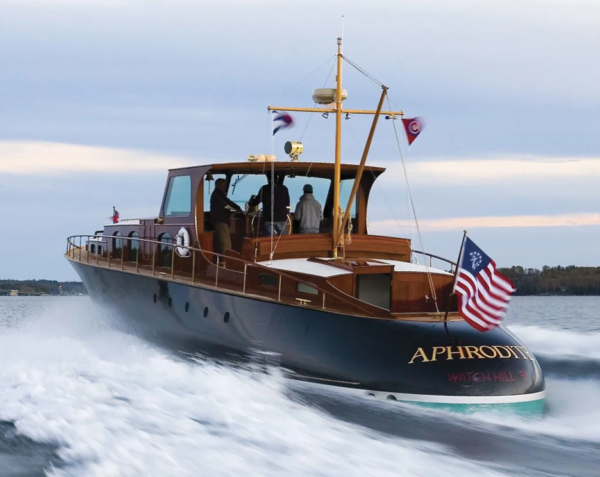
This mighty 1937 Purdy commuter yacht, Aphrodite , was completely restored at Brooklin Boat Yard with design support from Stephens Waring. Her rehabilitation shows how traditional design and technological innovation each have their place on the water. With redesigned propulsion and steering systems, new tanks and plumbing systems, and completely revamped interior, she offers a thrilling glimpse at what yachting was like in the 1930s—with all the comforts of today. Photo credit: Benjamin Mendlowitz
And in the fast-fashion world we live in, where it seems like half of what we buy has been replaced with a newer version before we leave the store, it gives us a good feeling to keep something old going, or better yet, to bring something from the past back to life.
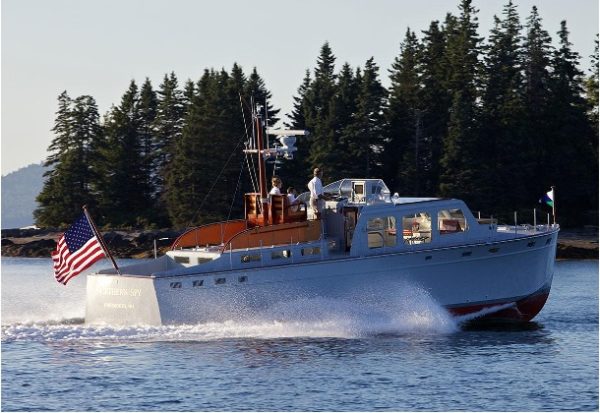
Stephens Waring worked with the owner of this classic 45’ Huckins, called Northern Spy , to rebuild the hull structure to accept the most modern of power plants: twin Volvo IPS drives. In the classic Huckins QuadroConic hull form, the IPS performs marvelously, boosting speed, cutting fuel consumption, and increasing maneuverability. Photo credit: Alison Langley
But for every unicorn rebuild project, there are plenty of renovation and restoration disasters along the way. Conversely, there is a mountain of smaller, less illustrious restorations and renovations, implemented successfully, which didn’t require the net worth of a Saudi Sheik to accomplish, but still extended the life and enjoyment of an old and beloved boat.
Big or small, iconic or sentimental, the key to any successful restoration project is figuring out how to identify the right fixer-upper and arming oneself with the knowledge to enter into a rebuild project with a clear understanding of the challenges, costs, and risks along the way.
Renovations vs. Restorations
The terms renovation and restoration are often used interchangeably. And while they may be close cousins, the goal and outcomes of a renovation or restoration project can be quite different in terms of objective, scope, and cost.
What is Restoration?

The bridge of Aphrodite was restored to match the original materials and controls of the vessel. Materials including varnished mahogany were carefully matched and rebuilt based on the original design specifications. Right image photo credit: Benjamin Mendlowitz
The primary objective of a restoration project is to bring a boat back to its original design and construction as closely as possible. Good restoration experts put significant time into researching the origins and background of the original build including understanding the history of the designer, construction techniques of the time, design philosophy, parts suppliers, and material sources.
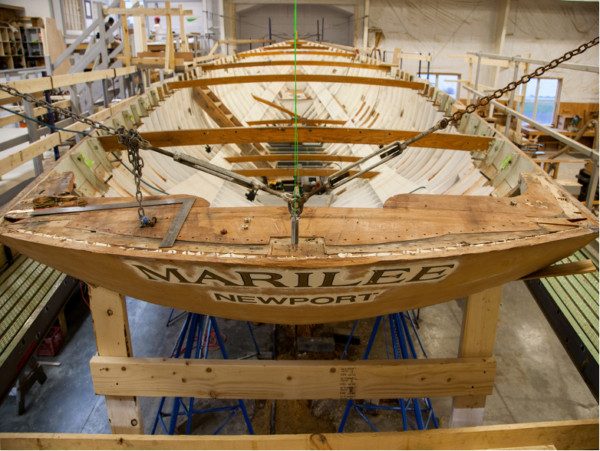
In 2014, French & Webb and Kurt Hasselbalch, curator of the MIT (Massachusetts Institute of Technology) Hart Nautical Collections, began restoration of Marilee originally built in 1926. In early winter 2014 they began with a 3D scan of the existing hull. This, combined with a CAD drawing created from the original Herreshoff plans, enabled the team to accurately examine Marilee’s current shape and compare it with the design from 1926. Photo credit: Alison Langley
Restoration experts often embark on a difficult treasure hunt as they scour the world for rare and comparable historical parts. This process can almost be as time consuming as the construction work itself.
During the restoration process, original materials are matched, and methods of construction are reused. Modifications from the original design are generally limited to changes necessary to bring a project up to modern codes and standards including electrical and life-safety. Stepping aboard a fully restored vessel should be like taking a step back in time.
What is Renovation?
Renovation is a much broader term. Generally speaking, it’s the process of renewing a boat or structure by fixing what’s present and adding something new or modern. This includes the integration of new materials, technologies, and even major structural design changes. We often think of a renovation as being built on the “spirit” of the original design while leaving the door open to new opportunities for creativity and innovation.
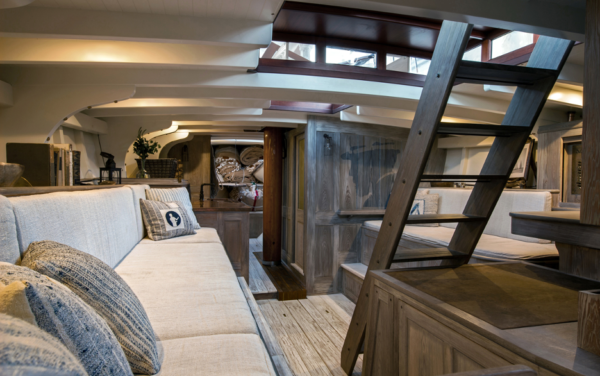
The owner of Marilee (built in 1926) had the bold vision to create an interior that reflected the yacht’s century-long provenance while creating an open space below. However, he wanted to get away from the dark “cigar room” interiors typical of so many classic yachts. The team worked with Paul Waring of Stephens Waring Yacht Design, to create a traditional and properly constructed interior with an updated layout for relaxed, modern day use. Photo credit: Alison Langley
Renovation can include adding new engines, propeller systems, updated electronics, efficient keels and hulls, and electrical systems. It can also include a refresh of the interior design elements and decor.
In some cases, renovation can be cheaper than restoration, especially for very old or historic boats where access to original parts and materials are rare or don’t exist at all.
Often renovations are completed in conjunction with restoration. In architecture we often see this with an old home or building where great lengths are taken to restore the exterior facade back to the original design, while inside, cutting-edge kitchens and bathrooms are installed. The effect is a blend of classic elegance with creature comfort and modern living.
What to Know Before Embarking on a Restoration or Renovation Project
There are no two ways about it, a major restoration or renovation can be costly and time consuming. They can also be extremely rewarding. The most successful projects are born from a sentimental and emotional objective rather than a purely economic consideration (although there are times when the economics pan out as well). Key to success is starting a restoration or renovation project with the right foundation. This may includes several of the following principles:
Starting with the Right Boat
Not all boats make good restoration projects. In fact, most don’t. The ones that do have that special something that may be referred to as being a “classic”. A good restoration candidate should have a historical or emotional value, or simply, a unique “wow” factor that makes it worthy of a second life.
Building on Good Bones
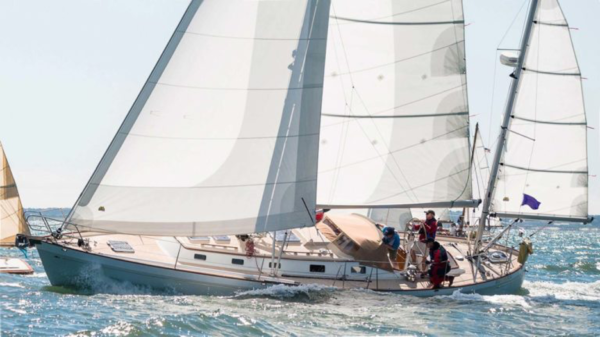
Zingara was originally designed by Bill Peterson, conceived to participate in the 1990 BOC-British Oxygen Company Challenge, a solo event ‘round-the-world yacht race. By the time we met her, the yacht was a long way from finished. Our renovation made the best use of her potential as a solid sailing yacht: the thoughtful design of the sailing platform, deck arrangement, and cockpit were to be functional in blue water; and down below her interior was to be spacious and comfortable, safe and relatively simple.
When possible, find a boat in which the problems are more cosmetic in nature than major costly systems repairs or replacements. At some point deterioration of major structures such as stringers and bulkheads may make restoration impractical. You should consider consulting with a professional designer like Stephens Waring to get an accurate assessment of major structural components and systems to fully understand the scope and resources necessary for a restoration or renovation.
Set a Realistic Budget and Timeline to Complete the Job
It is said that God created the world in seven days. That’s probably because he didn’t have to clean up anyone’s mess first. Realize that restoration and renovations are often as time and resource consuming as the original build itself. It takes time to undo the bad and rebuild with the good. Sweat equity can only carry your project so far and there are many hard costs and professional skillsets you’ll need to complete a big job. Working with a professional can help to set a realistic budget and define clear expectations and goals.
Size Does Matter
It’s easy to want to bite off more than you can chew. However, as a boat gets bigger the complexities of the systems become exponentially larger. The difference between a 30’ and 40’ boat can be immense. Experts generally recommend that no one attempt to restore a boat bigger than 35’ without professional support.
Where to Make Your Money Go the Distance
When done correctly, there are a number of benefits to upgrading and renovating rather than buying new. The key is to identify where to get the most bang for the buck. Finding a project where cosmetic repairs are the main problem is the best place to get a strong ROI. Renovations such as replacing upholstery, fixtures, refinishing surfaces, and painting can do wonders to make an old vessel feel new and increase the economic value.
Where to Start
Whether looking to renovate a boat you currently own or looking to purchase a used fixer-upper, we strongly suggest starting with a professional evaluation. Engaging an expert to inspect the hard to reach structures and systems can save a lot of money in the long run. A renovation expert like Stephens Waring can also help determine a solid triage strategy for what to discard, repair, and replace. For bigger projects, having a design expert create a detailed design and engineering plan, complete with 3D renderings, can provide a way for owners to better conceptualize the scope, cost, and outcome of the renovation and finished product.
Further Reading:
The Renovation of Marilee
The Renovation of Zingara
site by: slickfish studios
- About Our Authors
- SRAS: Study Abroad or Online
- GeoHistory: Geopolitics, History, News
- PopKult: Popular Culture
- Museum Studies: Museum Science, High Culture, City Planning
- Students Abroad: Travel Guides

Popular articles

View of the Kremlin and surrounding area from 1825. From The Album of Ancient Views of the Moscow Kremlin , by Ivan Zabelin. Available online from the Yeltsin Library .
The Kremlin: Moscow’s Historical Heart Through the Ages
Published: December 3, 2021
The Moscow Kremlin has long been the main symbol of Moscow and Russia – and for good reason. It was with the Kremlin that city of Moscow officially began and from which it grew. The Prince of Moscow, ruling from the Kremlin and drawing on the growing power of his city, united and conquered the cities and lands around him to create Russia.
While the Kremlin can be seen as something of a constant in Russian history, the Kremlin itself has seen major changes within its walls and to its own status. It has lost and gained buildings. It has changed from the seat of government to an ancillary structure, back to the governmental seat, and finally to a museum complex.
The resource below unites the work of multiple SRAS students writing on Home and Abroad , Challenge Grants , and Online Research Internships to bring you an overarching view of this iconic complex.
The Kremlin Walls
By Hudson Dobbs
The Kremlin was first established in 1156 by Prince Yuri Dolgorukiy. This post-dates the first mention of Moscow, which dates back to 1147, when Prince Dolgorukiy invited Prince Sviatoslav of Chernigov to Moscow to celebrate their alliance.
The actual site of this stronghold has likely been occupied since the second millennium BCE. It likely had fortifications built there as early as the 10th century, by the then-resident Vyatichi, a tribe of Slavic peoples.
Eventually, Prince Dolgorukiy ordered the construction of what would become the Kremlin walls. These first walls were tall and expansive and built out of wood. Although this structure was built for protection, it also served as a symbol for the power and strength of the new city of Moscow.
While the first walls did their job well, they were eventually burnt down by Tatar-Mongol forces and later upgraded to more fire-resistant oak in 1339. As the city grew, the Kremlin also further developed, and with it the popularity of building fortresses in town centers. Cities such as Smolensk, Kazan, Novgorod, and Pskov all constructed a Kremlin of their own. In fact, the word “kremlin” simply means “a fortress within a city.”
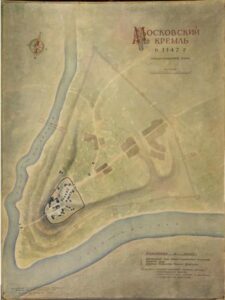
By the 13th century, the Kremlin housed the political and spiritual power of the state, with residences, workshops, churches, and state buildings all residing within its walls. In the 1360’s, Prince Dmitry Donskoy rebuilt the walls in limestone and a gleaming white Kremlin soon became the iconic image of Moscow. These walls were credited in helping the city defend itself from sieges by Grand Duke Algirdas of Lithuania in the late 1360’s.
The walls and towers that exist today are still another iteration, and were built on the order of Grand Prince Ivan III, also known as Ivan the Great, from 1485 to 1495. Ivan wanted to build something grander and more worthy of being his residence – something that would be comparable to Constantinople in terms of size and importance.
Wanting what would be specifically a “Third Rome,” Ivan invited Italian architects such as Aristotele Fioravanti and Pietro Antonio Solari. Their involvement is why the current fortress closely resembles castles of Northern Italy. Its red brick made the Kremlin unique for the time, as it was the first structure in Russia built from such material.
These brick walls have stood, with minor adjustments, since that time. One noticeable change came in the late 1600s, when Tsar Fyodor Alekseevich ordered the red brick to be whitewashed in limestone, returning it to gleaming white the city had been hitherto known for. Eventually, the whitewash stopped being maintained and was allowed to wear off, a process that was complete by the 1900s.
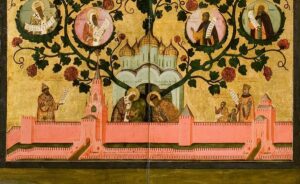
Grand Kremlin Palace Tour
By Jack Fisher
Formerly the Moscow residence of the Russian tsars, the Grand Kremlin Palace (not to be confused with the State Kremlin Palace) is a complex inside the Kremlin. It now hosts diplomatic meetings and official state ceremonies including presidential inaugurations. It is also designated as a residence of the President of the Russian Federation, but is rarely used for that purpose.
When SRAS gave me the opportunity to take an exclusive tour of this complex, which is an exclusive tour that is normally off-limits to the general public, I had to take it.
This particular tour is different from those that cover the more public areas inside the Kremlin and requires signing up early and submitting your documents for a security check.
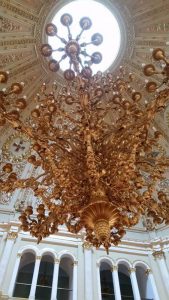
I met the tour group on a Friday afternoon in Aleksandrovski Sad, which borders the Kremlin walls. From there, we made our way towards the Kremlin grounds entrance. There was a huge line to get into the grounds through a first security checkpoint, but we were able to skip straight to the front of it since we had registered for our tour ahead of time. Once we were through the gate, the crowd thinned out significantly.
As we walked through the Kremlin grounds, we saw other tour groups taking photos of the landscaping, palace, and other historical buildings. Unlike us, they didn’t have the permission of the Russian government to enter the actual palace. When we got to the palace, we walked through the front doors, crossed a second security checkpoint, met our guide, and started the tour.
Our tour guide inside the building was a woman that worked in preservation. She only spoke Russian, so everything was translated for us by an SRAS-hired guide to English. We began on the first floor of the newer section of the palace and saw several ornate living rooms and guest rooms, followed by the empress’s and emperor’s chambers. Unfortunately, we weren’t allowed to see the emperor’s office and bathroom as President Putin had decided to use them as his personal study for the remainder of his time in office.
After the first floor, we headed upstairs to the second. From the outside the palace appeared to have three floors, but in reality the second floor just had massive, vaulted ceilings and two levels of windows. From what I saw, the second floor seemed to be where the fun happened. The first major room we walked into was the Hall of the Order of St. George, built to house major military meetings and balls and today used as a large conference room. There were names of famous military officers and soldiers inscribed on the walls, and the hall looked like it could hold hundreds of guests. Then it was on to the Hall of the Order of St. Vladimir, which was way less cool. It did, however, have the largest chandelier in the palace, for what that’s worth.
Next, we moved into the oldest section of the palace. It was built in the late 1400s and the newer sections of the palace were built out to connect with it. Our guide told us that by the time of the last czars, the older section was used strictly for ceremonial purposes. The walls were covered with paintings of historical rulers and religious figures. It was definitely my favorite room as there seemed to be an aura of timelessness hanging about the place.
Then we went back through the Hall of the Order of St. Vladimir and through another hall to the older bedchamber of the czar and an older, smaller meeting room for the czar and his nobles. This section was markedly different as there was none of the opulence of the newer palace. It had a utilitarian feel due to its practical layout with comfortable but plain looking chairs, reasonably sized paintings, low ceilings and large traditional Russian stoves.
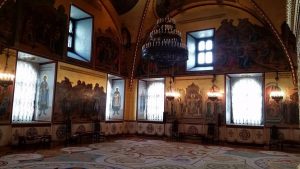
Finally, we visited the throne room. It was massive, just like the Hall of the Order of St. George, and had polished stone and gilding everywhere. Unfortunately, it was a reconstruction. Our guide let us know that the soviets had torn it apart when they came to power, creating what looked like a massive classroom to house the first meetings of the Soviet Congress. The Russian government had restored it completely within the past decade. She also let us know that the current heir to the Russian throne is Prince Harry of England, which is an interesting fact I’ve been surprising Brits with lately.
On our way out, we exited through a portrait hall. Most of the portraits were typical Enlightenment and Victorian era paintings with stuffy looking people. However, one painting caught my eye: the portrait of Knyaz Sbyatoclav. The man looked absolutely hardcore (and you can see him below in a photo I took).
In my opinion, it was definitely worth $75. While I wouldn’t go twice, the fact of the matter is that you get to see the inside of a beautiful building and stand in rooms that very powerful people meet in and have met in for hundreds of years – which is an opportunity that few regular people are given. Don’t think that it’s too expensive, because you’ll have the experience and memory with you for the rest of your life.
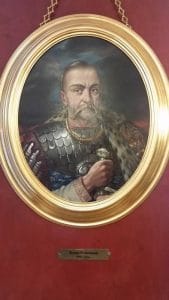
The Kremlin Without a Capital (1712-1918)
By Lee Sullivan
The Kremlin has always been a symbol of Russian power and authority. It is often used interchangeably with the Russian state in journalism and academic literature. This is not surprising considering the Kremlin is situated in the heart of Moscow and has typically housed Russian rulers and their offices – and continues to contain an official residence and office for Russian president Vladimir Putin. However, not all of Russia’s leaders have always called the Moscow fortress home. This article covers the nearly 200 years of Kremlin history when Moscow was not the capital.
Peter the Great moved Russia’s capital from Moscow to St. Petersburg in 1712. Despite the continued crowning of tsars in the Annunciation Cathedral and symbols of power in the Kremlin vaults, Moscow’s role in state life was minimal compared to that of the new capital. This changed when a new stage of construction began under Catherine the Great. Even though St. Petersburg was the new capital, she was crowned in Moscow following ancient tradition. A commission to replace the code of laws from Tsar Alexey Mikhailovich’s time was called in Moscow and its session was held in the Kremlin’s Faceted Palace. This was a sign that under Catherine the Great the state would be ruled from both St. Petersburg and Moscow. Additionally, the Senate was divided into departments under Catherine. Four were in St. Petersburg and two were in the newly commissioned Senate Building, which still stands in the Moscow Kremlin.
Catherine additionally planned a grand reconstruction of the Kremlin interior, one that would have seen most of its buildings demolished, save for the historic cluster of churches, and replaced with modern imperial architecture built with long, straight roads, much like St. Petersburg itself. Demolition was started, including to parts of the original Kremlin walls, when cracks began to appear in one of the cathedral walls due to the resulting disruption of the soil. Because of this, and because of the project’s already enormous cost, it was cancelled, and the original walls re-built.
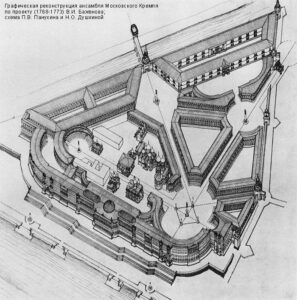
In September of 1812, French troops occupied Moscow. Napoleon, who led them, planned to occupy the Kremlin as his residence. It is widely thought that in defense against the French, the Moscow mayor ordered fires be set across the city. They raged for days so and were so intense that Napoleon was forced to leave the Kremlin due to the smoke. Upon returning he declared an intention to remain in the Kremlin for winter and ordered additional fortification of the Kremlin walls. However, the French army was weakening due to battle loss and poor supply.
Napoleon ordered his troops to retreat and blow up the Kremlin in the process. Mines were laid but their effectiveness was reduced by rain and prompt Muscovite response. Still, considerable damage was done, including to the Vodozvodnaya Tower, which was completely destroyed.
The Kremlin quickly underwent restoration under Tsar Alexander I and Nicolas I. Despite the war’s considerable drain on state funding, Tsar Alexander I prioritized restoring many parts of the Kremlin including towers, walls, palaces, and cathedrals. He often traveled to Moscow to observe the restoration progress. Many of Russia’s best architects were included in the restoration efforts. Order was progressively restored to the Kremlin and new gardens, now called the Alexander Gardens, were laid out along its exterior. Buildings like the Senate were brought back to their original appearance.
Restoration was completed under Nicholas I, who gave special attention to the restoration of ancient Kremlin churches and other old buildings. He also commissioned the construction of new buildings like the Great Kremlin Palace, after having the old one demolished. The entire imperial family attended the palace blessing during an official ceremony in April 1849. It was constructed and designed with techniques that were ahead of their time – vaulted construction for walls and ceilings, inlaid stone floors, and iron rafters.
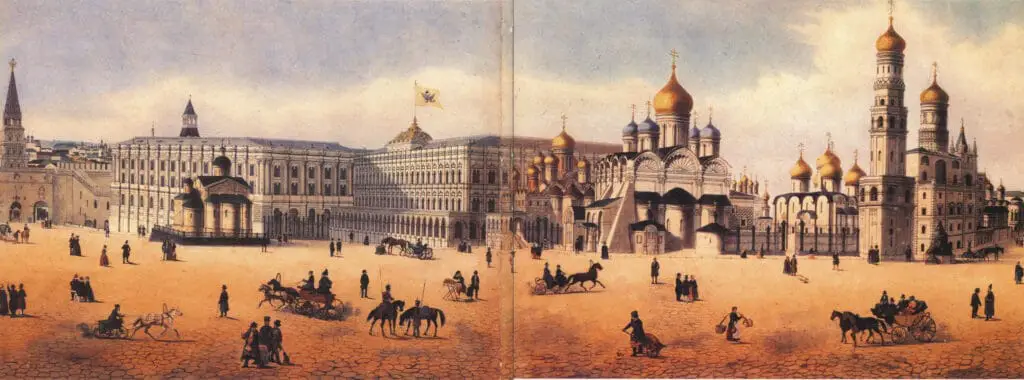
Shortly after the revolution, the Communists restored Moscow as the official capital in 1918 when Moscow was reinstated as Russia’s capital. Construction and restoration were completed by the mid-19 th century. During the Soviet years, the Kremlin housed Soviet leaders and saw the development and then dissolution of the Soviet state. Today the Kremlin stands in Russia’s capital as a unique architectural ensemble.

The Kremlin Under the Soviets
The new Bolshevik government made sweeping changes to the historic Kremlin complex to, as they saw it, better represent the character of the new socialist state.
During the revolution of November 1917, the Kremlin was ransacked, leaving it with broken glass, destroyed icons, and parts of the complex in disrepair. Restoration of the walls and towers began in 1918, but further restoration stalled for lack of funding and because the communists had not yet decided on a plan for their changes to their seat of government.
The first targets were churches and royal symbols. Nuns and monks who had long lived in the Kremlin were removed. Churches had valuables removed and transferred to the new Commissariat of Finances to fund state projects. Many royal treasures and even crown jewels were similarly transferred. The double-headed eagles on the top of the buildings were promptly removed.
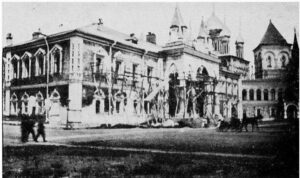
Many buildings were repurposed. Initially, many were converted to housing for Communist functionaries as the revolution and war had depleted Moscow’s housing stock while driving immigration from the countryside to the city. At one point, over two thousand people lived inside the Kremlin. By 1939, however, Kremlin residents consisted of only about three dozen high ranking officials.
Other notable repurposings included turning the Palace of Facets into a canteen with its kitchen inside the Tsarina’s Golden Chamber. The Ivan the Great Bell Tower was turned into a workshop, the Small Nicholas Palace became a worker’s club, and a gym was placed in the Church of St. Catherine. In 1932, the Andrew and Alexander Halls within the palace were gutted to make room for a party congress.
Many of the buildings and statues within the complex were destroyed, often to make way for new construction; only 26 of the original 54 buildings survived the Soviet period. The Chudov Monastery and Ascension Convent were both destroyed to make way for a military academy and eventually the Kremlin Presidium was built on the ground to house the Supreme Soviet, the supreme legislative body of the USSR.
In 1929, the Maly Nikolaevsky Palace, a former royal residence, was replaced by a new administrative building.
In the 1920s, the Russian royals buried in the Archangel Cathedral on the Kremlin’s Cathedral Square were exhumed and autopsied. They and the items in their sarcophagi were turned over to the Kremlin museum. Some valuable artifacts were requisitioned to the state treasury.
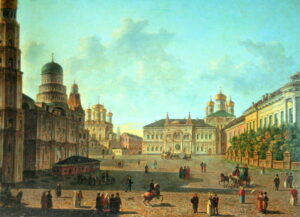
In 1935, five stars of rubied glass replaced the double-headed eagles that once topped the Kremlin gate towers.
Throughout WWII, the Kremlin was disguised under mock construction and painted roofs. Despite this, several bombs still fell on the Kremlin grounds, but did not cause major damage.
In 1947, Stalin painted the Kremlin walls red in an unmistakable ode to socialism, a drastic change from the traditional white that the walls had carried for centuries.
In 1955, the Kremlin opened to the public as an open air museum. In that same year, a ban on living in the Kremlin was introduced, lessening any security risk opening it to the public might create.
The last wave of demolitions came in 1958-1961, when the Palace of Congresses, built to house the congresses of Communist Party and cultural events, replaced the Old Amoury and part of the Patriarch’s Palace.
In part due to the outcry from this massive renovation, greater care of the Kremlin grounds began. The official Kremlin museum system was established in 1966, and Elena Gagarin, daughter of Yuri Gagarin, was hired as museum director. Today, that system includes the large armoury, several churches, and items outside of the Kremlin, such as St. Basil’s Cathedral.
The changes made during the Soviet period have left the Kremlin with a striking architectural contrast between traditional, tsarist-era architecture with Soviet-style buildings and the iconic, ancient red walls and remaining cathedrals. Despite the destruction and changes that were carried out, the compound still offers an unforgettable look into Russian and Soviet history that is impossible to get from anywhere else.
The Kremlin Stars
Translated by Caroline Barrow
The following was originally posted to the the Russian 7 website . It has been translated here by SRAS Home and Abroad Translation Scholar Caroline Barrow. Additional edits and updates were applied in 2021.
On October 24, 1935, two long-standing symbols of the Russian monarchy—the two-headed eagles which stood on top of the Kremlin towers, were ordered to be brought down and replaced with five-pointed stars.
Why a five-pointed star became the symbol of the Soviet regime is unknown, but what is known is that Lev Trotsky supported this symbol. Greatly fascinated by the esoteric, he knew that stars and pentagrams have a strong energetic potential and are one of the strongest symbols. The swastika could have easily become the symbol of the new government, since it had a strong following in Russia at the beginning of the twentieth century. Swastikas were displayed on the currency of the temporary government led by Alexander Kerensky, and swastikas were painted on the walls of Empress Alexandra Fedrovna’s Ipatiev House before the royal family was executed there. This swastika trend was stopped almost solely by Trotsky and the Bolsheviks, who opted for the five-pointed star. The history of the twentieth century even showed that stars are stronger than swastikas… Stars shone over the Kremlin, in the place of two-headed eagle.
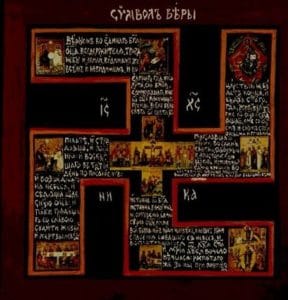
Erecting the thousand-kilogram stars on the Kremlin towers was not a simple thing to do. The problem was that the needed technology did not exist in 1935. The smallest of the Kremlin Towers, Borovitskaya, rose to 52 meters, and the tallest tower, Troitskaya, reached a height of 72 meters. Throughout the country, there were no tower cranes capable of reaching these heights. However, for Russian engineers, the word “no” did not exist, only the phrase “we must.” Engineers designed and built special cranes that could be installed on the upper deck for each tower. A metal base, called the console, was mounted at the base of each turret window, and on each console the engineers mounted a lifting crane. Thus, the process occurred in several stages: first the two-headed eagles were dismantled, and second, the stars erected.
Each star weighs about one ton. Given the height at which the stars would be placed and the fact that each star has a surface area of 6.3 square meters (potentially excellent for catching the wind), there was a danger that the stars might be blown away along with the top of the towers. So, it was decided to stress test the towers and, it turns out, with good reason: the upper part of each tower and its console was completely destroyed in the process. So, builders reinforced the masonry at the upper levels of the towers, and for the Spasskaya, Troitskaya, and Borovitskaya Tower, metal bracing was added to the base of the tower. The console on Nikolskaya Tower was so damaged that it had to be completely rebuilt.
All the stars were not made identical; four stars differ from one another in their artistic forms. On the Spasskaya Tower star, rays go out from the center. However, on Troitskaya Tower’s star, the rays look like spikes. The star on Borovitskaya Tower is made up of two contours, one inscribed in the other, and, finally, the rays on Nikolskaya Tower’s star have no pattern. In terms of length, the Spasskaya and Nikolskaya Towers were similar, with the distance between the ends of the rays being about 4.5 meters. On Troitskaya and Borovitskaya Towers, the star rays were shorter, and the distance between the ends of the rays was less, measuring 4 and 3.4 meters, respectively.
A star is good, but a spinning star is twice as nice. Moscow is large, its people many, and all must see the Kremlin stars. For the base of each star, special bearings were produced by the First Bearing Plant. These special bearings allow the stars to rotate with the wind even despite their significant weight. Consequently, it is possible to know the direction of the wind given the position of the stars.
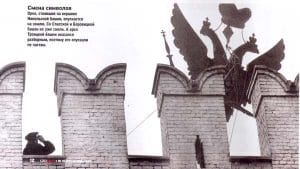
Installation of the Kremlin Stars was a true celebration for Muscovites. The stars were not carried under the cover of night to Red Square. The day before the stars were placed on the towers they were put on display in Gorky Park. District and City Secretaries of the Communist Party came together with the ordinary mortals below to see the stars. The stars were lit from the outside to make the Ural stones shine and the rays sparkle. The eagles, taken off the towers, were also displayed to visually demonstrate the dilapidation of the “old” world and the beauty of the “new” world.
The Kremlin stars were not always ruby glass. The first stars, installed in October, 1935, were made from high-alloy stainless steel and red copper. In the center of each star, on both sides, the stars were embedded with precious stones outlining the hammer and sickle emblem. Over the course of a year, the glitter of the gems dimmed. The stars were also found to be too big, not fitting well with the architectural ensemble. In May, 1937, it was decided to install new, illuminated glass ruby stars. Also, they added a star to a fifth tower, the Vodovzvodnaya Tower. The ruby glass was produced at a factory in the city of Konstantinov, according to the method of the Moscovite glassmaker, N. I. Kurochkina. It was necessary to prepare 500 square meters of ruby glass, and for that, a new type was invented—selenium ruby glass. Before that, gold was used to color the glass; selenium was cheaper and produced a deeper color.
The Kremlin stars don’t only rotate, they also light up. In order not to overheat and cause damage, about 600 cubic meters of air is blown through the stars per hour. The stars are not affected by power outages, because they have their own, independent generators.
For the original lighting, the Moscow Electrical Lamp Plant produced the lights for the stars. The stars on Spasskaya, Troitskaya, and Nikolskaya Towers all had 5000-watt bulbs, and the other two operated at 3700 watts. In each star, two parallel filaments were installed. That way, if one burned out, the other filament still shone and a control panel is was notified of the burnout.
To change a bulb, one need not need to climb up to the star. Rather, the bulb comes down on a special rod that runs straight through the bearing. The whole process takes 30-35 minutes. In the stars’ history, the stars stopped shining only twice—once during the war, and another time for the filming of the now-classic movie The Barber of Siberia .
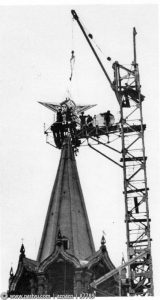
Editorial Note: Update 2021. Starting in 2015, the lighting of the Kremlin stars was updated with one star’s lighting system replaced each year. The old incandescent lamps were replaced with modern metal halide lamps. These lamps are approximately four times more energy efficient than the old bulbs and provide a more intense, higher-quality light. Metal halide lamps are often used for sports stadiums and other places where strong, high-quality light is needed.
In preparation for this switch, Employees of the Central Scientific and Restoration Design Workshops (TsNRPM) measured the illumination of each arm of each star separately to make sure that each would still be lit evenly and brightly. They also created models of the stars lit with various methods including LED matrices and optical fiber. In the end, metal halide was determined to be the closest in historical appearance to the existing incandescent lamps.
Within this update, each star was also given its first compressive maintenance since 1946. Damaged panes were replaced, the stars were cleaned inside and out, and the lubricants within the rotation system were replaced with modern fluids.
The State Kremlin Palace
By Benjamin Bradley Mulick
Finished in 1961 after three years of work, the Palace of Congresses, later renamed as the State Kremlin Palace (not to be confused with the Grand Kremlin Palace), opened its doors for the first time for the 22nd Congress of the Communist Party of the Soviet Union, welcoming thousands of party delegates as well as communist leaders from around the world. Today, it is still the Kremlin’s newest building and a multipurpose facility, housing large conventions, cultural displays from around the world and even its own ballet troupe. With these functions giving it continued purpose, the Kremlin’s most modern and out of place building is also one of its most significant.
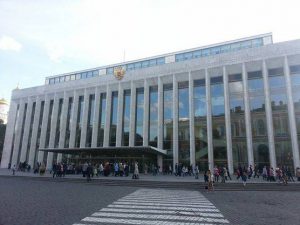
The Kremlin State Palace stands out from the gilded, pastel buildings around it with its hulking angular lines, and large windows divided by tall marble columns. It’s crowned by a glass banquet hall, which was the brainchild of Khrushchev himself.
It features three main halls: The Great Hall, the Small Hall, and the Diplomatic Hall. The Great Hall is the largest, featuring the palace’s main stage and hosting its most important events. With a seating capacity of six thousand, it is where party congresses were held, and where some of Russia’s most prominent cultural programs take place today. The Small Hall hosts smaller musical performances, and by virtue of having removable seating, also hosts dance events, such as the World Cup of Latin American Dance, as held in June of 2021. The Diplomatic Hall provides a smaller and more intimate setting in which to enjoy performances. Last but not least, the Diplomatic Hall often hosts lesser-known artists, often performing genres that do best in closer settings, such as jazz and folk.
The facility also holds many smaller meeting rooms, intended as breakout rooms for conventions, but also used for various purposes today.
The construction of the State Kremlin Palace came with considerable controversy. Not only is it stylistically wildly inconsistent with the rest of the Kremlin’s buildings, one of Russia’s most oldest and most important historical ensembles, but it also resulted in the destruction of several older buildings to make ways for the Palace’s massive presence.
The demolished buildings included the Old Kremlin Armory Building, originally built in 1851 to house the Kremlin’s ceremonial guard and a collection of state documents and treasure. The northern wing of the Patriarchal Chambers was torn down, formerly part of the private quarters of the head of the Russian Orthodox Church.
Because these were officially designated historic buildings, the legality of razing them was questionable and likely would not have taken place had not the decision been made from the office of Khrushchev himself.
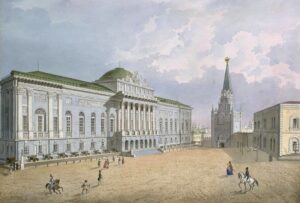
Perhaps the real loss, however, came from underground. The original plans for the palace, before the Second World War, envisioned it as truly massive facility built where Christ the Savior Cathedral now stands. In the Khrushchev era, it was planned to build a smaller but still very large building near MGU, along the river, in what were then the still-developing outskirts of the city. When Khrushchev decided to place it inside the Kremlin, its footprint was again shrunk and it faced restrictions on its height so that the view of the Dormition Cathedral would not be entirely lost.
To make up for this, the bottom part of the building was sunk sixteen meters into the valuable archeological depths of the Kremlin’s soil. The buildings torn down to make room for the Palace were themselves built over much older foundations.
Archeologists were given a short window to explore the former Palace of Natalya Narishkina, the mother of Tsar Peter I, as well the former sites of churches, royal kitchens, workshops, and studios in what was once an economic center based within the historic Kremlin.
Teams of archaeologists were assigned to the area, who, in addition to expected finds, also found a number of secret tunnels. Unfortunately, while the archaeologists did their best to learn and preserve what they could, the limited timeframe allowed by the construction of the State Kremlin Palace meant that the archaeological potential of the site was, in large part, wasted. The tunnels were filled in, the old foundations built over, and the ruins lost to history.
Today, the Palace is perhaps best known as the home of The Kremlin Ballet, which was specifically formed in 1990 under esteemed Russian artist and choreographer Andrey Petrov with the purpose of performing there after the Bolshoi Ballet stopped performing at the palace and returned to the Bolshoi, then under renovations.
While the Kremlin Ballet was created with a strong basis in the classics, they have made more recent contributions to the ballet world with a number of their own classically-inspired modern works, including a ballet adaptation of Mark Twain’s The Adventures of Tom Sawyer .
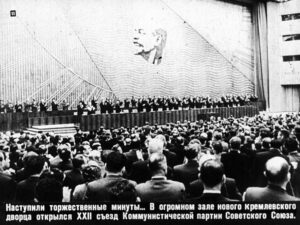
The State Kremlin Palace also hosts the Moscow Classical Ballet, which has been dancing in Moscow since 1966. Demonstrations of this tradition in the upcoming year will include the Moscow Classical Ballet’s dancing reinvention of Romeo and Juliet (which was considered scandalous when it was first performed in 1972), and a performance of Swan Lake , one of Russia’s most important contributions to dance, as performed by the Kremlin Ballet.
Built to hold important political events, the State Kremlin Palace is more a cultural building than a political one. The stage’s relatively short history promises to be subsumed by its promising future. Whatever the next big musical or cultural phenomenon in Russia is, the State Kremlin Palace will be a part of it.
- Read a review of The Snow Maidan as performed at the State Kremlin Palace on this site.
A Tour of the Moscow Kremlin Today
Tour as reviewed by Helen McHenry, 2019
As part of our SRAS cultural program, we were given the opportunity to take a tour of the Kremlin, a historic complex and symbol of the Russian government. We met our guide outside of Red Square before walking along the Kremlin walls to the visitors’ entrance. She pointed out the swallowtail merlons bordering the wall, a design popular in 15th century Italian-style architecture, before we mounted the battlement. To travel behind the Kremlin walls, we crossed a bridge that used to span the Neglinnaya River but today acts as an archway covering part of the footpath.
Inside the Kremlin is an intriguing mix of old and new – from the 15th century walls to the 20th century block of modernism known as the State Kremlin Palace. Our guide informed us of the controversy over the palace’s design, which stands in such contrast to the more traditional styles surrounding it. The building, built under Khrushchev’s leadership primarily as a government meeting hall, has almost as many floors underground as it does above ground. Although many cried out against the building when it was built, it still stands today, where it is now used mainly to host concerts.
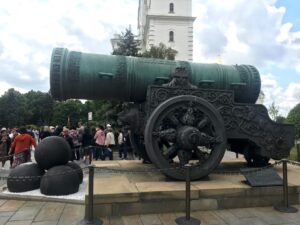
A brief walk along a path lined with cannons from the state artillery collection brought us to what appeared to be the mother of all cannons. Indeed, the Tsar Cannon is the largest bombard by caliber ever manufactured and has never been used due to its vast size. Just around the corner lay a similarly large but unused item – the Tsar Bell. Commissioned during the time of Empress Anna, niece of Peter the Great, an almost life-size image of her adorns the bell’s surface.
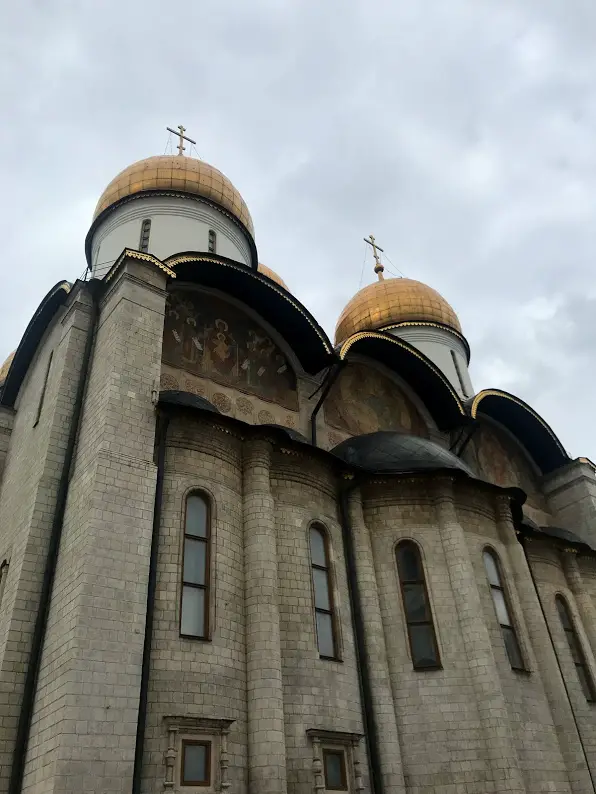
We then traveled to Cathedral Square, which, as its name suggests, features a number of beautiful cathedrals. The overcast day did nothing to accentuate the gold domes that capped their many towers, but no amount of gloom could dim their impressive stature – so immense that photographing them from my vantage point proved a challenge. Each cathedral was adorned with more stunning iconography than the last, overwhelming to the point of monotony as we shuffled through the throngs of tourists.
Our next visit was to the State Armoury, a neoclassical building resplendent with the wealth of the tsars. We traipsed through room after room of riches, from icons, dishware, and diplomatic gifts to clothing, carriages, and thrones. What stood out to me the most was the two distinct – and sometimes warring – natures of Russian identity on display at the Armoury, East and West. The contrast was particularly obvious amongst the collections of clothing, weaponry, and thrones. The older pieces hearkened back to the time before the Western pivot of Peter the Great. While these remained just as ornately decorated as their modern counterparts, they were, on the whole, a lot less outlandish than those done in the styles of the West.
The Armoury marked our last stop within the Kremlin, so we traveled across the city center to the Cathedral of Christ the Savior. Although the cathedral is the world’s largest Orthodox church, the current building is not the original. Christ the Saviour was demolished under the reign of Stalin and was only rebuilt in the late 1990s. Since then, the cathedral has gained fame as the site of Pussy Riot’s 2012 performance, which landed three members in jail for “hooliganism.”
Our guide let us explore the church on our own, as the church requires groups to be led by its own guides. Looking forward to lunch, we opted for a quick pass through the cathedral. Had I not been so hungry, I could have spent hours inside, as every surface held intricately-painted religious imagery intermixed with adornments heavily gilded with gold. Photographs were not allowed within the cathedral, reserving this spectacle to be seen first-hand.
The Kremlin in its entirety is a spot I recommend to all visiting Moscow, as four hours within its walls was not enough for our group to even scratch the surface of the wonders within.
Tour as Reviewed by Joseph Ozment, 2016
As part of SRAS’s Russian as a Second Language (RSL) program at Moscow State University, I had the opportunity to attend a guided walking tour of the Kremlin and its museums. We had a professional tour guide provided by SRAS who was very well informed about all aspects of the Kremlin’s sites and always willing to answer questions.
The tour, as offered by SRAS each session, can differ slightly based on availability and timing. We began our day’s tour not at the Kremlin, but at the nearby Cathedral of Christ the Savior, Russia’s largest Orthodox cathedral and one of the largest Christian structures in the world. Note that there are wardrobe requirements for entering the church (men and women both must have their shoulders covered, while men cannot wear shorts and women must wear skirts at least beneath the knee).
Before going inside, we were taken around the massive structure, and given a brief yet informative overview of its history. We learned that, despite the classical style of the building, it is actually only about 20 years old, having been constructed to resemble the church that once stood on the same ground.

During Communist times, the ground on which the Church now stands was a massive swimming pool, having been filled with water after the original Church was destroyed. The plans that the Communists originally had for the site were to construct the headquarters of the Communist Party of the Soviet Union, which would be one of the tallest structures in the world and house the office of the Soviet Union’s premier inside the head of a giant Vladimir Lenin statue adorning the top.
The Cathedral is a truly stunning structure. Comparable only to St. Peter’s Basilica in Rome in my mind, the sheer amount of open air is amazing when one considers how still and tranquil it is on the inside.
We then continued onwards to the Kremlin itself, which was teeming with guided tours from all over the world, just like ours. Seeing other groups from America, but also some from France, Italy, China, and several other European and Asian countries was very interesting, as people tend not to think of Russia as a popular tourist destination. However, tourism here has grown rapidly in recent years, particularly since the ruble lost about half its value on world markets, making Russia a much more affordable location.
Anna informed us of the purposes of all of the first structures we encountered within the Kremlin walls. First of all, though, she made sure that we were aware that the word “Kremlin” does not refer just the center of government in Moscow, but is a general word that means fortress. Most Russian cities and towns of reasonable size and with a medieval history possess a Kremlin.
We saw one of the offices in which President Putin occasionally works, as well as the large, semi-controversial event and concert hall that resides just inside the main entrance to the Kremlin. Despite its modern style that clashes somewhat with the comparatively ancient structures around it, the fact that the building is covered in glass at least ensures that it reflects the beauty and history that abounds within the Kremlin.
After seeing the aptly named Tsar Cannon and Tsar Bell, both of which are two of the largest objects of their kind in the world, and neither of which have been used for their structural purpose in their existence, we moved on to see several of the many churches that stand within the walls of the Kremlin.
Inside the Church of the Annunciation, we were informed of some of the basic components of any Russian Orthodox Church. For starters, every inch of wall is covered in some image or another, from icons of Saints to giant murals that depict judgment day and the people of earth being sent either to heaven or hell. We also learned that the altar in an Orthodox church is given its own room, to which only the priests are allowed entry. The mysticism that is native to Orthodoxy and inherent to its liturgy was embodied in all aspects of these churches.
After our tour of the Kremlin’s outside squares, we were taken on a tour of the Armory Museum, which houses outfits, household items, carriages, armor, weapons, and various sundry items that belonged to the Tsars and Tsarinas of Russia. Anna knowledgeably led us through the various styles worn by different Russian rulers, and explained the significance(s) behind the appearance of what they wore and the carriages in which they rode.
We were in awe of the beautiful jewels that encrusted everything the royals wore and every vessel out of which they drank or off of which they ate, not to mention of the thrones on which they sat. We saw gifts from foreign dignitaries and rulers, and even the museum’s collection of Faberge creations.
All in all, it was a day rich with history and made even more enjoyable by our friendly and incredibly knowledgeable tour guide, Anna. There is hardly a more essential Russian experience to have during your time in Moscow than a guided tour of the Kremlin.
Incidentally, Anna, a guide that SRAS has worked with for years, helps run a guiding collective in Moscow called Bridge to Moscow . They run many private tours and are available for custom tours and travel as well.
Latest Updates
By Josh Wilson
In addition to the changes to how the Kremlin stars are lit and renovations to the Kremlin bells in Spasskaya Tower , for instance, several recent events are of interest.
In the mid-2000s, the Russian Orthodox Church lobbied for the restoration of the Chudov Monetary and the Ascension Convent within the Kremlin walls. The idea was seriously considered and even discussed on television by President Vladimir Putin, although only in the sense of rebuilding them as cultural monuments and part of the museum complex, rather than as working religious institutions. In the end, however, the Kremlin Presidium was simply torn down in 2016 and the area left mostly open with fragments of the old foundations left under glass for viewing. The result is a Kremlin even more dominated by open space and gardens.
Wind has damaged the Kremlin walls on a few occasions. In June 1998, several of the iconic sparrow tail structures on the wall were damaged by strong winds. In April 2018, strong wind damaged the Senate Palace roof. In October 2021, scaffolding being used to restore a section of the inner wall was blown over the top of the wall, also damaging several of the iconic sparrow tail structures. In all cases, the damage was quickly repaired.
You Might Also Like
The Moscow Kremlin has long been the main symbol of Moscow and Russia – and for good reason. It was with the Kremlin that city of Moscow officially began and from which it grew. The Prince of Moscow, ruling from the Kremlin and drawing on the growing power of his city, united and conquered the […]
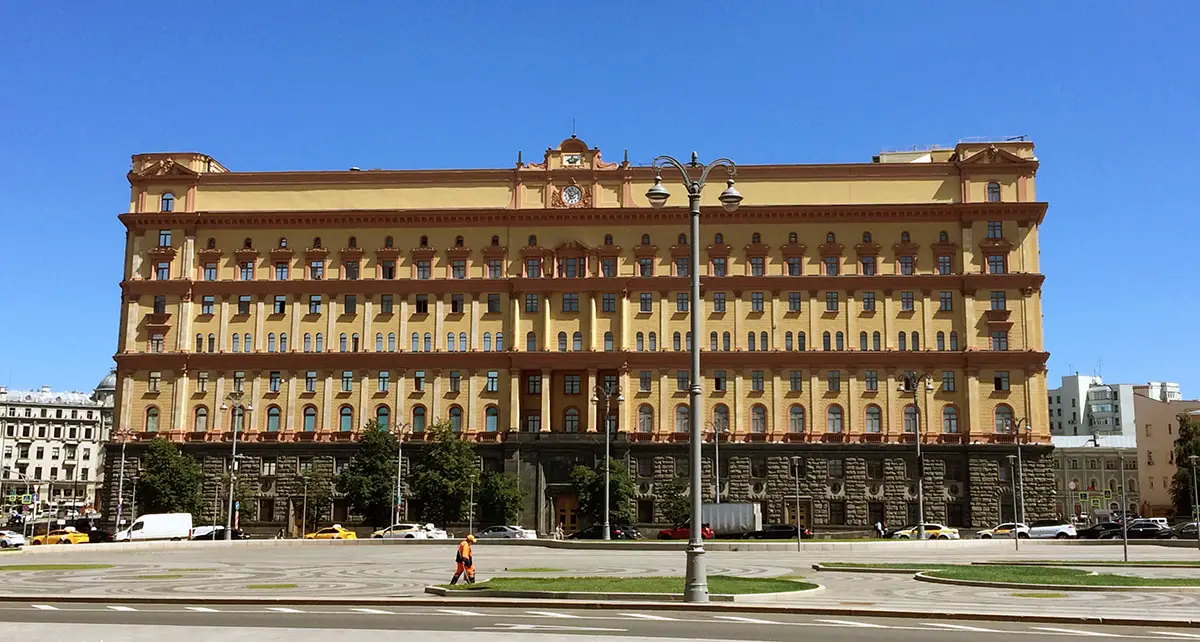
Lubyanka: Inside the Story of Moscow’s Infamous Building and District
There is always history surrounding us. In a city like Moscow, this can seem overwhelmingly apparent. Moscow has many imposing buildings from many eras – some are immediately recognizable and others only invite wonder as to what stories lay behind their beauty or grime. Lubyanka is the name commonly used to refer to the building […]
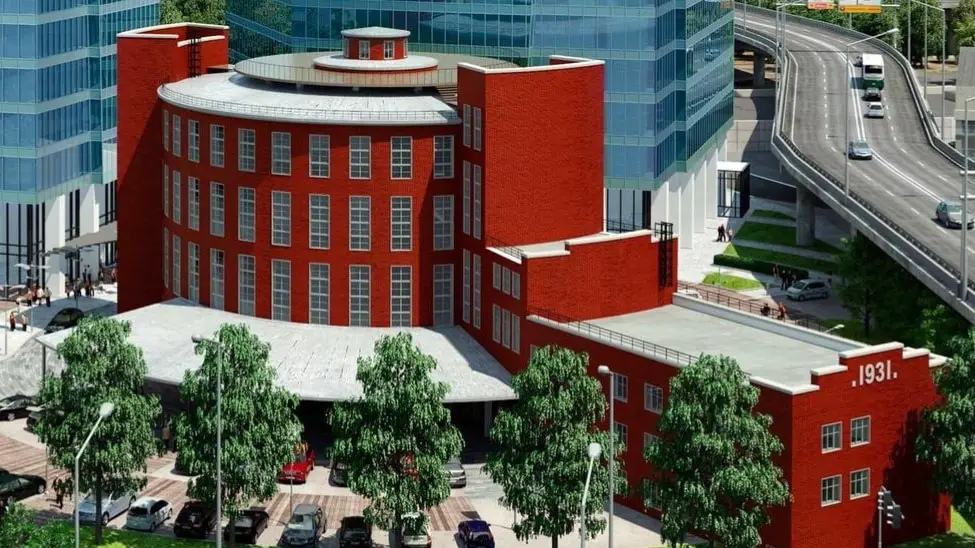
Supermetal: The Latest in Moscow’s Urban Redevelopment
By the end of 2020, the founders of Khlebozavod9 and The Brusov Ship will open a new public space near Baumanskaya metro station in Moscow. A former industrial zone will host the Supermetal Cultural and Business Complex. The team’s plans call for two architectural monuments, laboratories with panoramic windows, three courtyards, and some small manufacturing […]
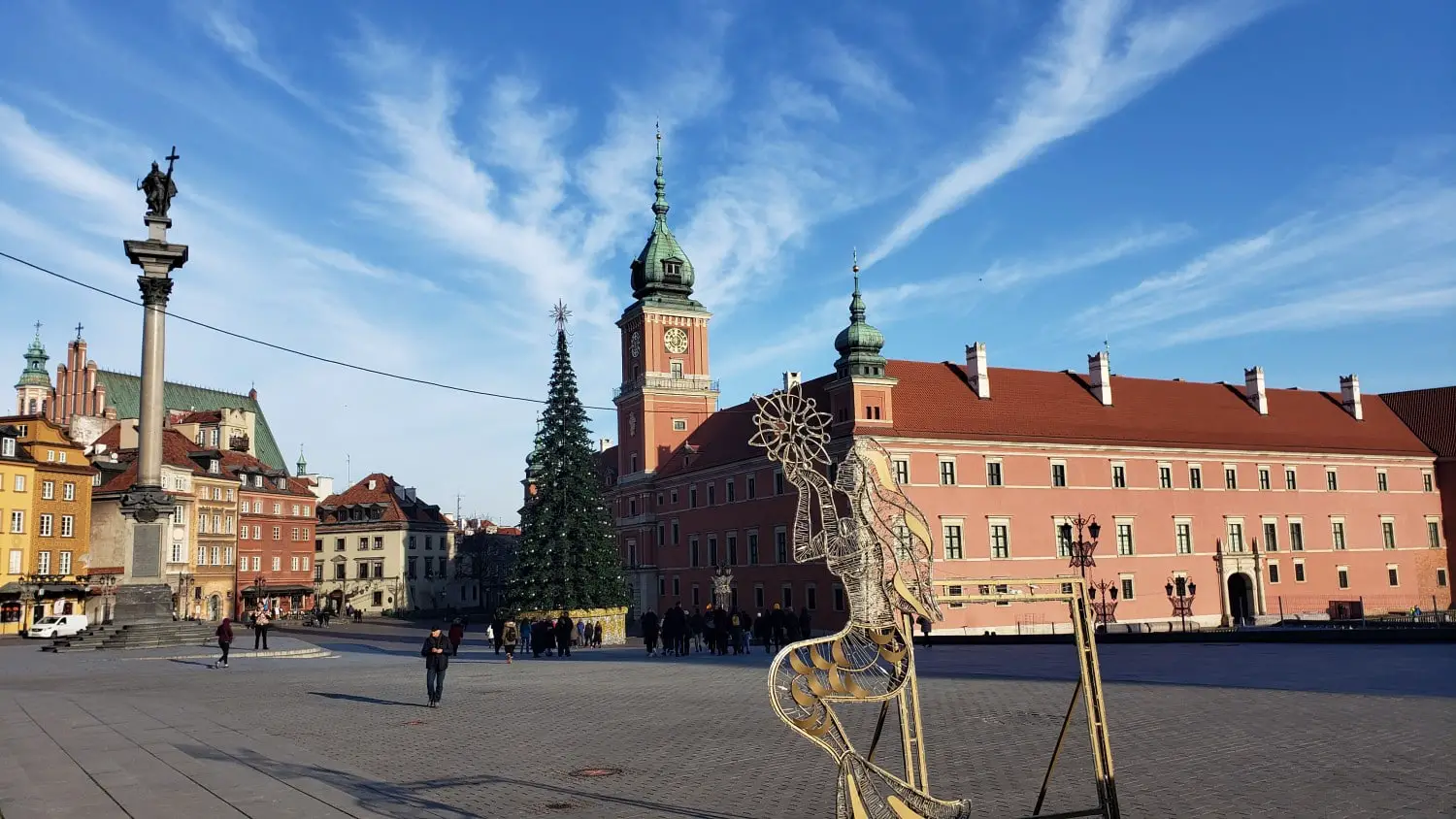
Warsaw’s Old Town District
While I was on study abroad in Warsaw, Poland, the place I visited most behind the Palace of Culture and Science, where I had classes every day, was Old Town. Why? Simply put, a trip to Old Town in Warsaw is like taking a journey back in time. It is the gem of the city […]

A Day in Tashkent’s Old City: Travel from Bishkek with SRAS
As part of SRAS’s Central Asian Studies program, students had the opportunity to travel to Uzbekistan for a full week. The first day of this week-long expedition began with a half-day tour of Tashkent’s old part of town. We were accompanied by our guide, Donat, or “Don” for short. He had outstanding English, and even […]

About the authors

Serena Keenan
At the time she wrote for this site, Serena Keenan was a rising junior at Smith College in Northampton, MA. She was majoring in Russian, East European, and Eurasian Studies with a minor in Government and a concentration in Translation Studies. She hoped to study abroad in Moscow during the spring 2022 semester. After college, she hoped to go on to work in nuclear nonproliferation. In her free time, she likes to read and crochet.
Program attended: Online Interships
View all posts by: Serena Keenan

Caroline Barrow
Caroline Barrow is a graduate of Texas A&M University with a degree in International Studies and Russian. She loves traveling and hearing people’s stories. Out of the places she’s been able to visit, her favorite was Kiev, Ukraine for its beauty, history, and friendly people. She received a Fulbright English Teaching Assistantship and, at the time she wrote for this site, was spending year teaching English in Kostanay, Kazakhstan. Additionally, she was been named SRAS’s Home and Abroad Translation Scholar for the 2013-2014 cycle. Her contributions included mostly translations of articles and blog posts that will be of interest to students.
Program attended: Home and Abroad Scholar
View all posts by: Caroline Barrow

Lee Sullivan
Lee Sullivan is an undergraduate student at Stetson University. She is currently pursuing a BS in cybersecurity and a BA in Russian, East European, and Eurasian studies. Next semester Lee will be in Vladivostok, Russia – studying the Russian language and participating in the Home and Abroad internship with SRAS. She aspires to pursue a master’s degree upon graduating.
View all posts by: Lee Sullivan
Benjamin Mulick
Ben Mulick, at the time he wrote for this site, was a fourth year Global Studies major at the University of Wisconsin–Milwaukee.
View all posts by: Benjamin Mulick

Jack Fischer
Jack Fischer, at the time he wrote for this site, was majoring in Physics with Russian and Economics minors at Iowa State University of Science and Technology in Ames, Iowa. He is studied Russian as a Second Language with SRAS over the summer of 2016 to improve his command of the Russian language. In the future, he’d like to work for himself and run a business, preferably abroad.
Program attended: Challenge Grants
View all posts by: Jack Fischer
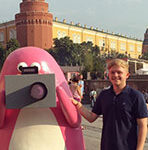
Joseph Ozment
Joseph Ozment is a fourth-year International Studies and Russian Studies major at Rhodes College in Memphis, TN. He is minoring in music minor and has spent a lot of free time on music projects. He is studying Russian as a Second Language and also working an internship with The Moscow Times. He hopes to increase his Russian skills and cultural awareness so as to use his knowledge of the country and language in a professional setting in the future.
View all posts by: Joseph Ozment
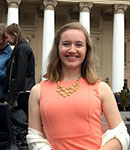
Helen McHenry
Helen McHenry, at the time she wrote for this site, was a double major in international relations and Russian at the Ohio State University, with minors in Spanish and public policy. She studied with Russian as a Second Language with SRAS at the Higher School of Economics in Moscow in order to advance her proficiency in Russian and appreciation for Russian culture. She hoped to use the knowledge gained during her time abroad to advocate for foreign policy that strengthens relations between East and West in her future career.
View all posts by: Helen McHenry

Julia Brock
Julie Brock, at the time she wrote for this site, had returned to University of Kentucky to pursue a Global Studies Certificate, with an emphasis on Russia and the travel industry. She earned prior BA and MA degrees in psychology. A few years ago, she traveled to Russia, Estonia, and Finland, and loves the culture and history of these areas. She works at the campus library, and enjoys reading, running 5Ks, and spending time with her dogs. She lived for five years in Minnesota and loved the snow, winter sports, and Museum of Russian Art.
View all posts by: Julia Brock

Hudson Dobbs
Hudson received his BA in Russian Studies with a minor in Corporate Communications from Baylor University. At the time he wrote for this site, he was serving as a Home and Abroad Scholar as part of a Spring, 2022 session of SRAS’s Language and Society program St. Petersburg. While abroad, Hudson will be researching the Russian coffee culture, as well as the evolution of specialty coffee in Russia. His goal is to open his own coffee shop in the US - taking his experiences abroad and applying them to his future business.
View all posts by: Hudson Dobbs

IMAGES
COMMENTS
Tom Owen Tom started working with wooden boats in 2002 when he attended the International Yacht Restoration School in Newport RI, USA. Since graduating from the Boatbuilding & Restoration Program there, he has used his traditional skills to restore a series of light to medium displacement racing yachts, dinghies and wooden craft from his workshop in Fowey, Cornwall.
Tom and his team produce quality work on wooden boats up to 45ft, specialising in classic yacht restoration of racing boats. His particular area of interest is light to medium displacement racing yachts. All restoration, new build or repair projects undertaken at the workshops in Fowey.
Specialising in classic yacht restoration and wooden boatbuilding; Particular area of interest is light to medium displacement racing yachts; All restoration, new build or repair projects undertaken; Winter and spring commissioning and repairs; Outside layup and storage area available for boats up to 35ft.
Tom Owen Classic Yacht Restoration. Top quality work on wooden boats up to 45ft. Specialising in classic yacht restoration and wooden boatbuilding. Particular area of interest is light to medium displacement racing yachts. All restoration, new build or repair projects undertaken. Winter and spring commissioning and repairs.
Claim business. Boat sales Yacht chandlers Insurance intermediaries Yacht brokers Boat yards Boat delivery Boat moorings Marinas. Find Tom Owen Classic Yacht Restoration in Fowey, PL23. Get contact details, videos, photos, opening times and map directions.
Working as a charter yacht, she was sold in 1986 to a Swiss businessman who ordered a complete restoration at New Zealand shipyard McMullen & Wing. The majority of the riveted hull was replaced, and the result was impressive: in 1996 she won the ShowBoats International award for Best Classic Yacht Restoration.
Top quality work on wooden boats from small dinghies up to yachts. Tom Owen • Classic Yacht Restoration & Wooden Boatbuilding Unit 4, Windmill Ind. Est., Fowey, Cornwall PL23 1HB www ...
Tom Owen Boat Building & Classic Yacht Restoration. Boatbuilding, maintenance & repair. Windmill, Fowey PL23 1HB, UK. 07976 403120 ... Quality work on wooden boats up to 45ft. Specialising in classic yacht restoration and wooden bo... Woodworks. Boatbuilding, maintenance & repair. Parc Peneglos, Mylor Bridge, Falmouth TR11 5SL, UK. 07968334163 ...
Find company research, competitor information, contact details & financial data for Tom Owen Classic Yacht Restoration of FOWEY. Get the latest business insights from Dun & Bradstreet.
913 Followers, 39 Following, 6 Posts - See Instagram photos and videos from Classic Yacht Restoration (@tomowenclassicyachts)
Tom Owen - Classic Yacht Restoration and wooden boatbuilding using traditional techniques and craftsmanship, Fowey, Cornwall Read More. View Company Info for Free. Who is Classic Yacht Restoration. Headquarters. United Kingdom. Phone Number +44 7976403120. Website. www.classicyachtrestoration.co.uk. Revenue
This mighty 1937 Purdy commuter yacht, Aphrodite, was completely restored at Brooklin Boat Yard with design support from Stephens Waring. Her rehabilitation shows how traditional design and technological innovation each have their place on the water. With redesigned propulsion and steering systems, new tanks and plumbing systems, and completely ...
43 likes, 2 comments - tomowenclassicyachts on January 11, 2017
More than 900 buildings and other landmarks have been renovated since 2011, with 182 of them completed this year. As usual, the best projects have received awards in the Moscow Restoration competition. The projects included: Baron von Rekk's estate mansion on Pyatnitskaya Street, monuments to Alexander Pushkin and Maxim Gorky, the flower beds ...
The one-story building with a superstructure in the center was built in the early 19th century and exemplifies a classic urban residential house of that time that survived the fire of 1812. Over the past 200 years, the building has been remodeled several times, and it was used for various purposes. Restoration of its historical appearance was ...
Yusupov Palace in Moscow dating back to the late 16th - early 17th century will soon be restored. The building is located at 21/4 Bolshoy Kharitonyevsky Pereulok. A federal significance cultural heritage site, it is officially called Volkov Boyars Chambers (Yusupov Palace). The listed building is owned by the state.
The Kremlin quickly underwent restoration under Tsar Alexander I and Nicolas I. Despite the war's considerable drain on state funding, Tsar Alexander I prioritized restoring many parts of the Kremlin including towers, walls, palaces, and cathedrals. He often traveled to Moscow to observe the restoration progress.